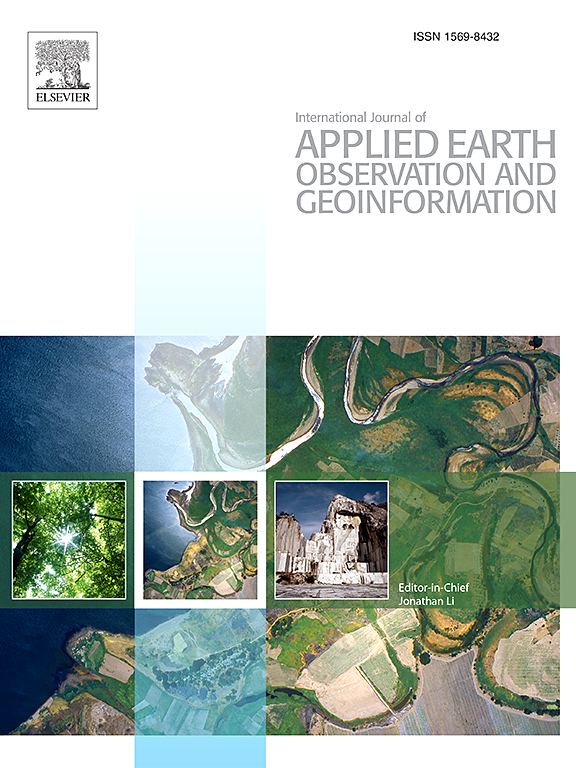利用sentinel-2图像和地形特征,采用深度学习方法和云计算平台支持,绘制10米全球露台地图
IF 7.6
Q1 REMOTE SENSING
International journal of applied earth observation and geoinformation : ITC journal
Pub Date : 2025-04-13
DOI:10.1016/j.jag.2025.104528
引用次数: 0
摘要
梯田农业在山区防止水土流失、优化土地利用和支持当地生态系统方面发挥着重要作用。然而,由于缺乏统一的自动识别模型,有关梯田全球分布的研究十分有限。尽管近年来深度学习架构发展迅速,但其在提取梯田地图方面的性能仍有待研究。针对这一局限性,本研究比较了八种最先进的深度学习模型的性能,包括 UNet、HRNet、DeepLabv3+、TransUNet、Segmenter、PVT v2、Swin-Unet 和 PerSAM。选择哨兵-2 图像是因为其光谱特性,而选择数字高程模型(DEM)图像则是为了获得详细的地形信息。UNet 在梯田识别方面的表现优于其他方法,总体准确率达到 92.8%,平均交叉比联合率 (MIoU) 为 75.9%。整个数据处理工作流程使用 Google 地球引擎采集数据、Google Drive 进行存储、Google Earth Pro 提供计算能力以及云计算资源中的 T4 GPU,大约需要 625 小时。梯田总面积估计为 853,161 平方公里,约占全球耕地面积的 5.1%。梯田面积最大的国家是中国(298,908 平方公里,占耕地总面积的 18%)、埃塞俄比亚(127,266 平方公里,占 47%)、肯尼亚(36,385 平方公里,占 37%)、印度(34,485 平方公里,占 2%)和刚果民主共和国(31,422 平方公里,占 21%)。预计这一开创性的全球梯田地图将弥补弹性农业领域的重大数据缺口。它将为了解梯田耕作制度的空间分布和属性及其在加强粮食安全和促进环境可持续性方面的作用提供宝贵的见解。本文章由计算机程序翻译,如有差异,请以英文原文为准。
A 10-meter global terrace mapping using sentinel-2 imagery and topographic features with deep learning methods and cloud computing platform support
Terrace agriculture plays a vital role in mountainous regions by preventing soil erosion, optimizing land use, and supporting local ecosystems. However, research on the global distribution of terraces is limited due to the lack of unified automatic identification model. Despite the rapid advancements in deep-learning architectures in recent years, their performance in extracting terrace maps still needs investigation. To address this limitation, this study compares the performance of eight state-of-the-art deep learning models, including UNet, HRNet, DeepLabv3+, TransUNet, Segmenter, PVT v2, Swin-Unet, and PerSAM. Sentinel-2 imagery was selected for its spectral properties, while Digital Elevation Model (DEM) imagery was chosen for detailed topographic information. UNet outperformed others in terrace identification, achieving an overall accuracy of 92.8 % and a mean Intersection over Union (MIoU) of 75.9 %. The entire data processing workflow, using Google Earth Engine for data acquisition, Google Drive for storage, Google Earth Pro for computational capabilities, and the T4 GPU in cloud computing resources, requires approximately 625 h. As a result, the Global Terrace Map (GTM) was generated at 10-meter resolution for 2022. The total terrace area was estimated at 853,161 km2, accounting for about 5.1 % of global cropland. The countries with the most extensive terraced areas, as identified, are China (298,908 km2, 18 % of total cropland), Ethiopia (127,266 km2, 47 %), Kenya (36,385 km2, 37 %), India (34,485 km2, 2 %), and Democratic Republic of the Congo (31,422 km2, 21 %). This pioneering global terrace map is anticipated to bridge a significant data gap in the field of resilient agriculture. It will offer invaluable insights into the spatial distribution and attributes of terraced farming systems, along with their roles in enhancing food security and promoting environmental sustainability.
求助全文
通过发布文献求助,成功后即可免费获取论文全文。
去求助
来源期刊

International journal of applied earth observation and geoinformation : ITC journal
Global and Planetary Change, Management, Monitoring, Policy and Law, Earth-Surface Processes, Computers in Earth Sciences
CiteScore
12.00
自引率
0.00%
发文量
0
审稿时长
77 days
期刊介绍:
The International Journal of Applied Earth Observation and Geoinformation publishes original papers that utilize earth observation data for natural resource and environmental inventory and management. These data primarily originate from remote sensing platforms, including satellites and aircraft, supplemented by surface and subsurface measurements. Addressing natural resources such as forests, agricultural land, soils, and water, as well as environmental concerns like biodiversity, land degradation, and hazards, the journal explores conceptual and data-driven approaches. It covers geoinformation themes like capturing, databasing, visualization, interpretation, data quality, and spatial uncertainty.
 求助内容:
求助内容: 应助结果提醒方式:
应助结果提醒方式:


